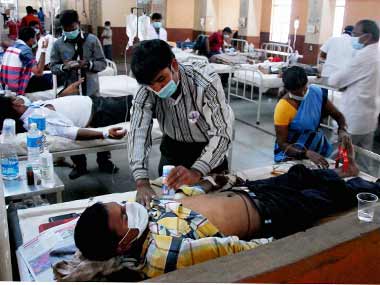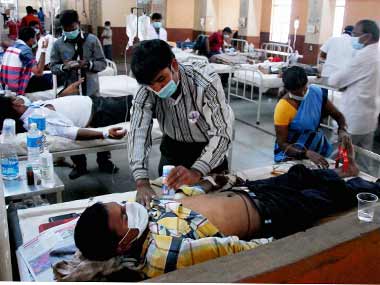The Indian healthcare system is facing a number of challenges, the largest being a loss of credibility. Many experts, waxing eloquent across print and electronic media and finding faults with the system often put the onus on the government ‘to do something’. However, this farrago of criticism not only fails to bring out real solutions, it builds pressure on policymakers which leads to knee-jerk reactions which further distract from real solutions. [caption id=“attachment_4325475” align=“alignleft” width=“380”]  Representational image. PTI[/caption] Healthcare is far too important to be treated in such a manner. On one hand, the policymakers need to have the will and capacity to get to the root of the problem and on the other hand, medical professionals also need to shun victimhood and self-regulate. India has a perennial shortage of doctors: More so in rural and semi-urban areas. The governments of Tamil Nadu and Maharashtra have passed laws to ensure medical graduates practise in rural areas. States such as Karnataka and West Bengal plan to follow their lead. However, this is nothing short of coercion. Such regulations will only end up being self-defeating. Bright youngsters will be more inclined to choose careers in ‘non-regulated’ fields such as engineering, finance and management, where fancy jobs and lucrative salaries await them, and shun the medical field. The right approach will be to incentivise young doctors to work in rural areas with better amenities, better salaries and perquisites such as preferential school admissions for their kids. Private institutions can be motivated through tax incentives or corporate social responsibility provisions. If offered stability and dignity, doctors will willingly work in rural areas. An acute shortage of qualified people to work as full-time teachers in medical colleges is another problem. To circumvent this, the managements of the medical colleges undertake all sorts of malpractices that range from the ludicrous to the laughable (for which the Medical Council of India must take a fair share of blame). A solution: Making better use of visiting faculty, a concept which has been well embraced by management institutes across the country. The permanent staff of a medical college can look after administration and maintain a panel of visiting teachers from the vast pool of practising doctors in various fields. Lectures can be uploaded to the college website. Such arrangement would appeal to many eminent practising doctors and incentivise them to share their knowledge and experience to the would-be doctors. This way, the practising doctors will get a sense of fulfillment, students will get better educated, and the colleges will save money. These external experts can be remunerated based on number of lectures, hospital rounds, or surgeries performed. Likewise, the system of deciding experience of pilots based on flying hours can be used to measure experience of teachers in the medical profession. ‘Medical negligence’ is another menace on the rise. However, one cannot ascertain the magnitude of the problem going by the coverage in the print and electronic media. They appear only too eager to create the impression that doctors and hospitals are out to kill or loot hapless patients. ‘Medical negligence’ is an over-simplified term used to blame for any adverse outcome. In the medical world, certain risks are universally known and accepted: Errors due to a lapse in judgment, adverse unintended reactions or sub-optimal results to the best line of treatment. They mean an adverse outcome could still be possible despite the best and honest efforts of the medical team. A recent World Health Organisation survey found one in ten hospital admissions results in an adverse outcome, while 1 in 300 hospital admissions led to unexpected death. It concluded that unintended medical error was among the top ten killers globally. An American study published in the Journal of American Medical Association (JAMA) in 2000 claimed that 225,000 deaths occurred in the US every year as a result of unintended medical error. However, the people as well as the US media are careful to distinguish ‘unintended medical error’ from ‘medical negligence’. The complexity of human body is such that a disease and outcome of its treatment is never a mathematical equation. The treatment which cures patient ‘A’, may have an altogether different and unintended outcome when administered to patient ‘B’. For example, a majority of dengue fever are treated as out-patients, but a few need extreme ICU care with blood transfusions, platelet infusions, and even ventilator support. For such a patient, the hospital bill will run into lakhs, and in the end, the patient may not even survive. If the treating doctors are accused of being ‘negligent’ in such cases, it is a tragedy of monumental proportions. Overuse of the term ‘medical negligence’ can not only ruin a doctor or an institution’s future, but will create a trust deficit between patients and doctors which has wider ramifications. Decisions will be delayed and it is the patient that will suffer. Hence, one must refrain from using the term ‘medical negligence’, unless it is abundantly clear that there indeed was negligence. A doctor’s hard work, and the fact that no doctor wants his patient dead, should be given due regard. In all this chaos, governments of Karnataka and West Bengal are charting a potentially disastrous course. Instead of improving the public healthcare system, they are trying to regulate the private sector: Private hospitals, nursing homes and individual private practitioners. Given that the private sector has ably shouldered the responsibility of the nation’s healthcare when the public sector is woefully short of talent, infrastructure and willpower, the policymakers’ desire to dictate terms — whom to treat, how to treat and how much to charge — is unfortunate. Clearly, there is neither any homework nor any long-term plan behind it. Over-regulation will only scare away the talent and stifle the healthcare sector’s growth. That will be a tragedy of Himalayan proportions. It is not that India’s healthcare system only has problems. In fact, getting proper medical care in India is much easier, quicker and cheaper than in the United States or United Kingdom, even though the doctor-to-population ratio is below par. For ordinary illnesses like the common cold, it takes nearly two weeks in the United States to get an appointment with the doctor. Compare that to India, where a patient can simply walk into any general practitioner’s clinic. Similarly, the cost of hospitalisation, on which such a hue and cry is made, remains merely a fraction of what it costs in the US. If India ‘wants’ doctors and desires quality healthcare at an affordable price, young talent must be incentivised and motivated rather than punished. At a time when the government is repealing archaic laws and reducing compliance burden to improve ease of doing business in India, a similar liberal approach is needed from the policymakers when regulating healthcare. Instead of scaring away the best of talent, the government ought to better equip the public sector healthcare and make it attractive. Let the policymakers not waste the tax payers’ money and the demographic dividend our prime minister talks about with such passion. Dr Gurunath Parale, (MD, DM, FACC), is Professor Medicine & Interventional Cardiologist with over 25 years of experience and Head of the Cardiology Department at Ashwini Co-operative Hospital, Solapur (http://www.drgurunathparale.com/) Dr Virupaksha Joshi, is Head of Radiology Department, Ashwini Co-operative Hospital, Solapur
The Indian healthcare system is facing a number of challenges, the largest being a loss of credibility. Many experts, waxing eloquent across print and electronic media and finding faults with the system often put the onus on the government ‘to do something’. However, this farrago of criticism not only fails to bring out real solutions, it builds pressure on policymakers which leads to knee-jerk reactions which further distract from real solutions.
Advertisement
End of Article


)

)
)
)
)
)
)
)
)



